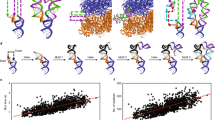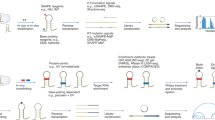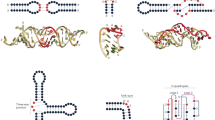Abstract
RNA secondary structure can be most simply visualized on the basis of runs of complementary bases in the primary sequence. These complementary regions predict an ability of a molecule to fold back on itself to form double stranded helical regions. Computer methods which utilize energy rules to predict a secondary structure for the entire molecule have been devised. These predictions can be made to accommodate other types of chemical and genetic analysis. The limitations of the modeling methods are discussed and their use in folding several RNA molecules is demonstrated. Regulatory mechanisms which may be controlled by RNA structure and amenable to genetic analysis are also discussed.
This is a preview of subscription content, access via your institution
Access options
Subscribe to this journal
Receive 12 print issues and online access
$209.00 per year
only $17.42 per issue
Buy this article
- Purchase on Springer Link
- Instant access to full article PDF
Prices may be subject to local taxes which are calculated during checkout
Similar content being viewed by others
References
Gold, L., Pribnow, D., Schneider, R., Shinedling, S., Singer, B.W. and Stormo, G. 1981. Translational initiation in prokaryotes. Ann. Rev. Microbiol. 35: 365–403.
Simons, R.W. and Kleckner, N. 1983. Translational control of 1S10 transposition. Cell 34: 683–691.
Sauer, R.T., Krovatin, W., DeAnda, J., Youderian, P. and Suskind, M.M. 1983. Primary structure of the immI immunity region of bacteriophage P22. J. Mol. Biol. 168: 699–713.
Mizuno, T., Chou, M. and Inouye, M. 1984. A unique mechanism regulating gene expression: translational inhibition by a complementary RNA transcript (micRNA). Proc. Natl. Acad. Sci USA 81: 1966–1970.
Olins, P.O. and Nomura, M. 1981. Translational regulation by ribosomal protein S8 in Escherichia coil: structural homology between rRNA binding site and feedback target on mRNA. Nucl. Acids Res. 9: 1757–1764.
Friesen, J.D., Tropak, M. and An, G., 1983. Mutations in the rplJ leader of Escherichia coli that abolish feedback regulation. Cell 32: 361–369.
von Gabain, A., Belasco, J.G., Schottel, J.L., Chang, C.Y., and Cohen, S.N. 1983. Decay of mRNA in Escherichia coli: Investigation of the fate of specific segments of transcripts. Proc. Natl. Acad. Sci USA 80: 653–657.
Kolter, R. and Yanofsky, C. 1982. Attenuation in amino add biosynthetic operons. Ann. Rev. Genet. 16: 113–134.
Selzer, G., Som, T., Itoh, T. and Tomizawa, J. 1983. The origin of replication of plasmid p15A and comparative studies on the nucleotide sequences around the origin of related plasmids. Cell 32: 119–129.
Masukata, H. and Tomizawa, J. 1984. Effect of point mutations on formation and structure of the RNA primer for colE1 replication. Cell 36: 513–522.
Mullin, D.A., Garcia, G.M. and Walker, J.R., 1984. An Escherichia coli DNA fragment 118 base pairs in length provides dnaY+ complementing activity. Cell (in press).
Walter, P. and Bloebel, G. 1982. Signal recognition particle contains a 7S RNA essential for protein translocation across the endoplasmic reticulum. Nature 299: 691–698.
Cech, T.R., Tanner, N.K., Tinoco, I.Jr., Weir, B.R., Zuker, M. and Perlman, P.S. 1983. Secondary structure of the Tetrahymena ribosomal RNA intervening sequence: Structural homology with fungal mitochondrial intervening sequences. Proc. Natl. Acad. Sci. USA 80: 3903–3907.
Zuker, M. and Stiegler, P. 1981. Optimal computer folding of large RNA sequences using thermodynamics and auxiliary information. Nucl. Adds Res. 9: 133–148.
Jacobson, A.B., Good, L., Simonetti, J. and Zuker, M. 1984. Some simple computational methods to improve the folding of large RNAs. Nucl. Acids Res. 12: 45–52.
Comay, E., Nussinov, R. and Comay, O. 1984. An accelerated algorithm for calculating the secondary structure of single stranded RNAs. Nucl. Acids Res. 12: 53–66.
Martinez, H.M. 1984. An RNA folding rule. Nucl. Acids Res. 12: 323–334.
Papanicolaou, C., Gouy, M. and Ninio, J. 1984. An energy model that predicts the correct folding of both the tRNA and the 5S RNA molecules. Nucl. Acids Res. 12: 31–44.
Goad, W.B. and Kanehisa, M.I. 1982. Pattern recognition in nucleic acid sequences, I. A general method for finding local homologies arid symmetries. Nucl. Acids Res. 10: 247–263.
Kanehisa, M.I. and Goad, W.B. 1982. Pattern recognition in nucleic-acid sequences, II. An efficient method for finding locally stable secondary structures. Nucl. Adds Res. 10: 265–278.
Hogeweg, P. and Hesper, B. 1984. Energy directed folding of RNA sequences. Nucl. Acids Res. 12: 67–74.
Shapiro, B.A., Maizel, J., Lipkin, L.E., Currey, K. and Whitney, C. 1984. Generating non-overlapping displays of nucleic acid secondary structure. Nucl. Adds Res. 12: 75–88.
Quigley, G.J., Gehrke, E., Rothe, D.A. and Auron, P.E. 1984. Computer-aided- nucleic acid secondary structure modeling incorporating enzymatic digestion data. Nucl. Acids Res. 12: 347–366.
Yamamoto, K., Kitamura, Y. and Yoshikura, H. 1984. Computation of statistical secondary structure of nucleic acids. Nucl. Acids Res. 12: 335–346.
Auron, P.E., Rindone, W.P., Vary, P.H., Celentano, J.J. and Vournakis, J.N. 1982. Computer aided prediction of RNA secondary structure. Nucl. Acids Res. 10: 403–419.
Needleman, S.B. and Wunsch, C.D. 1970. A general method applicable to the search for similarities in the amino add sequences of two proteins.J. Mol. Biol. 48: 443–453.
Smith, T.F. and Waterman, M.S. 1981. Identification of common molecular subsequences. J. Mol. Biol. 147: 195–197.
Martinez, H. 1983. An efficient method for finding repeals in molecular sequences. Nucl. Acids Res. 11: 4629–4634.
Woese, C.R., Magrum, L.J., Gupta, R., Siegel, R.B., Stahl, D.A., Kop, J., Crawford, N., Brosius, J., Gutell, R., Hogan, J.J. and Noller, H.F. 1980. Secondary structure model for bacterial 16S ribosomal RNA: phylogenetic, enzymatic and chemical data. Nucl. Acids Res. 8: 2275–2293.
Swerdlow, H. and Guthrie, C. 1984. Structure homology of introncontaining tRNA precursors. J. Biol. Chem. 259: 5197–5207.
Gauss, D.H. and Sprinzl, M. 1984. Compilation of tRNA sequences. Nucl. Acids Res. 12: rl–r58.
Haseloff, J., Mohamed, N.A. and Symons, R.H., 1982. RNAs of cadang-cadang disease of coconuts. Nature 299: 316–321.
Delilas, N. and Andersen, J. 1982. Generalized structures of the 5S ribosomal RNA's. Nucl. Acids Res. 10: 7323–7344.
Erdmann, V.A., Wolters, J., Huysmans, E., Vandenberghe, A. and De Wachter, R.D., 1984. Collection of published 5S and 5.8S ribosomal RNA sequences. Nucl. Acids Res. 12: rl33–rl66.
Maizel, J.V. and Lenk, R.P. 1981. Proc. Natl. Acad. Sci. USA 12: 7665–7669.
Mount, D.W. and Conrad, B. 1984. Microcomputer programs for graphic analysis of nucleic acids and proteins. Nucl. Acids Res. 12: 811–818.
Gross, H.J., Domdey, H., Lossow, C., Jank, P., Raba, M. and Alberty, H. 1978. Nucleotide sequence and secondary structure of potato spindle tuber viroid. Nature 273: 203–208.
Tinoco, I., Borer, P.N., Dengler, B., Levine, M.D., Uhlenbeck, O.C., Crothers, D.M., and Gralla, J. 1973. Improved estimation ot secondary structure in ribonucleic acids. Nature New Biol. 246: 40–42.
Borer, P.N., Dengler, B., Tinoco, I. and Uhlenbech, O.C. 1974. Stability of riboriucleic acid double-stranded helices. J. Mol. Biol. 86: 843–853.
Salser, W. 1977. Globin rnRNA sequences: Analysis of base pairing and evolutionary implications. Cold Spring Harbor Symp. Quant. Biol. 62: 985–1002.
Fitch, W.M. 1983. Calculating the expected frequencies of potential secondary structure in nucleic acids as a function of stem length, loop size, base composition and nearest neighbor frequencies. Nucl. Acids Res. 13: 4655–4663.
Beck, E. and Bremer, E. 1980. Nucleotide sequence of the gene ompA coding the outer membrane protein II of Escherichia coli K-12. Nucl. Acids Res. 8: 3011–3024.
Inokuchi, K., Mutoh, N., Matsuyama, S. and Mizushima, S. 1982. Primary structure of the ompF gene that codes for a major outer membrane protein of Escherichia coli K-12. Nucl. Acids Res. 10: 6957–6968.
Author information
Authors and Affiliations
Rights and permissions
About this article
Cite this article
Mount, D. Modeling RNA Structure. Nat Biotechnol 2, 791–795 (1984). https://doi.org/10.1038/nbt0984-791
Issue Date:
DOI: https://doi.org/10.1038/nbt0984-791



